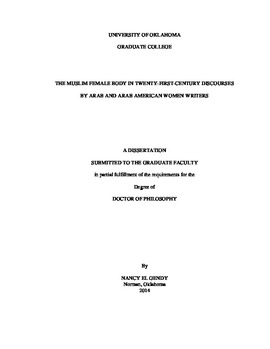| dc.description.abstract | Abstract
The Muslim Female Body in Twenty-First-Century Discourses by Arab and Arab American Women Writers employs a culturally symptomatic approach in its reading of various modes of representation of the Muslim female body. Analyzing visible as well as buried topics in selected twenty-first century Arab and Arab American women’s novels, the dissertation examines dominant cultural constructions of the body within socio-political frameworks. In this context, both present and absent themes are equally important for understanding the production of knowledge by a literary text and, hence, the culture(s) a text symptomizes. To this end, it studies four twenty-first-century novels by Arab American women authors and three novels by Arab women writers, including Syrian American Mohja Kahf’s The Girl in the Tangerine Scarf (2006), Jordanian American Diana Abu-Jaber’s Crescent (2003), Palestinian American Randa Jarrar’s A Map of Home (2008), Egyptian American Samia Serageldin’s The Cairo House (2000), Egyptian Nawal El Saadawi’s Zeina (2010; trans. 2011), Saudi Arabian Rajaa Abdalla Al-Sane’s Banāt al-Riyāḍ (2005); trans. Girls of Riyadh (2007), and Egyptian Bedouin Miral al-Tahawy’s al-Khibāʾ (1996); trans. The Tent (1998).
Part of the contribution of this dissertation is that it puts in the foreground what is in the background. By this I mean, it minutely traces and scrutinizes scattered details about the subject of the body of Muslim women across 21st-century Arab and Arab American women’s literatures. Its main claim is that the perception of the Muslim female body is based on cultural fabrications. It seeks to deconstruct dominant one-dimensional interpretations of the position of the Muslim female body today, by laying out the multiplicity of the ideological constraints that the body currently confronts. It views those ideologies as interwoven constituents of a web. At the same time, it teases out multiple modes of resistance that these writers develop to counteract Orientalist, Islamist, and other powers which manufacture and enforce dominant body images. The dissertation highlights the heterogeneity of the authors it deals with, paying close attention to the singular subjectivities of their production of knowledge. To do so, it shows how differences are augmented, multiplied, and rendered more nuanced when delineated within diasporic as well as national contexts. It evaluates how each novel positions itself in relation to damaging ideologies by assessing the counter-images that the writers create. The study discusses how those counter-pictures trouble, adhere to, or refute conventional constructions.
This project is both appreciative and critical of Michel Foucault’s theory of the body. It extends Louis Althusser’s theory of ideology. In analyzing the social construction of the Muslim female body, it aligns itself with a handful body theorists, particularly Gayle Rubin, Elizabeth Grosz, Susan Bordo, and Lennard J. Davis.
Keywords: Arabophobia, Body Politics, Counterhegemonic Powers , Diaspora, Discourse, Feminism, Gender Construction, Habitus, Identity Politics, Ideology, Islamism, Islamophobia, Oppositional Cultures, Orientalism, Survivance, the Veil, and Zionism. | en_US |
